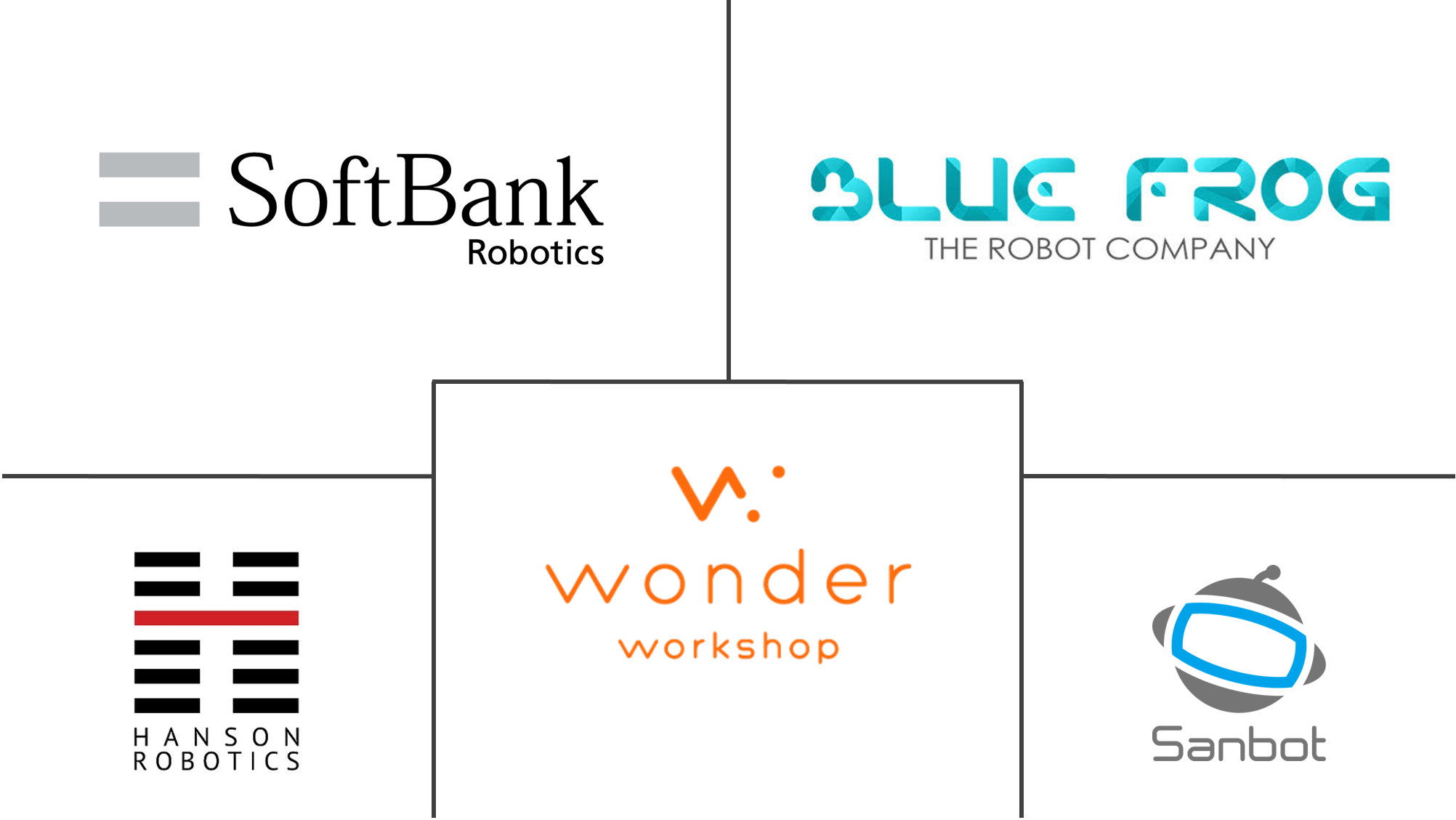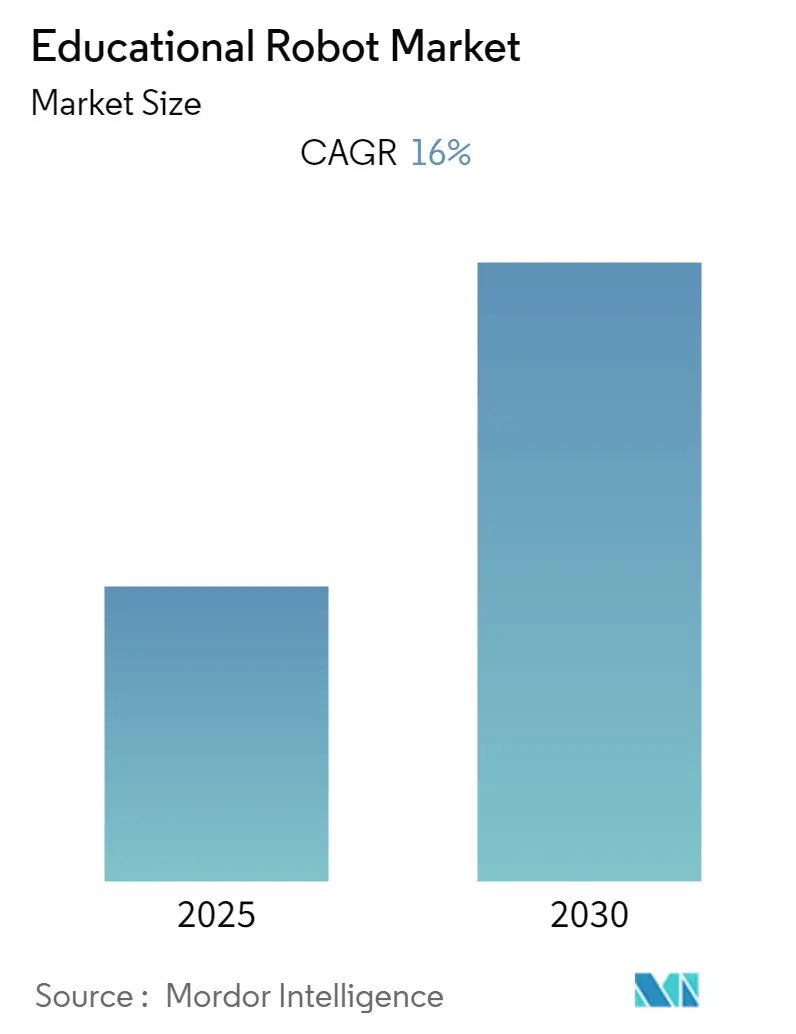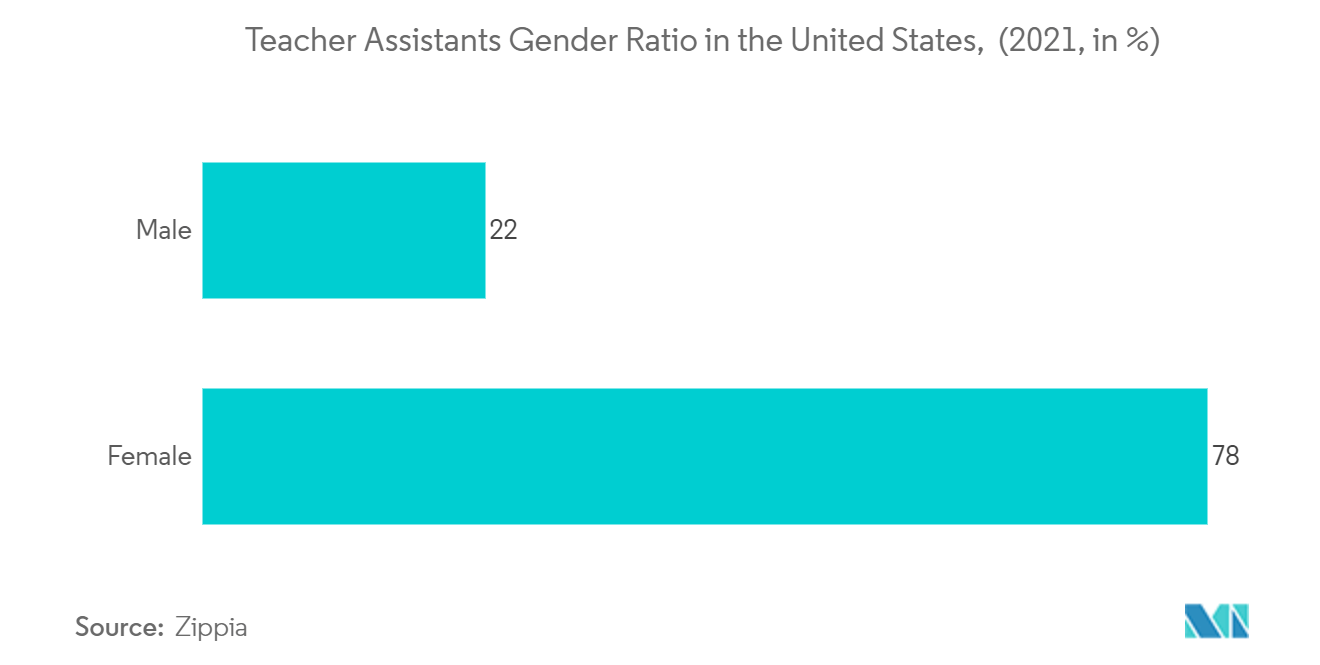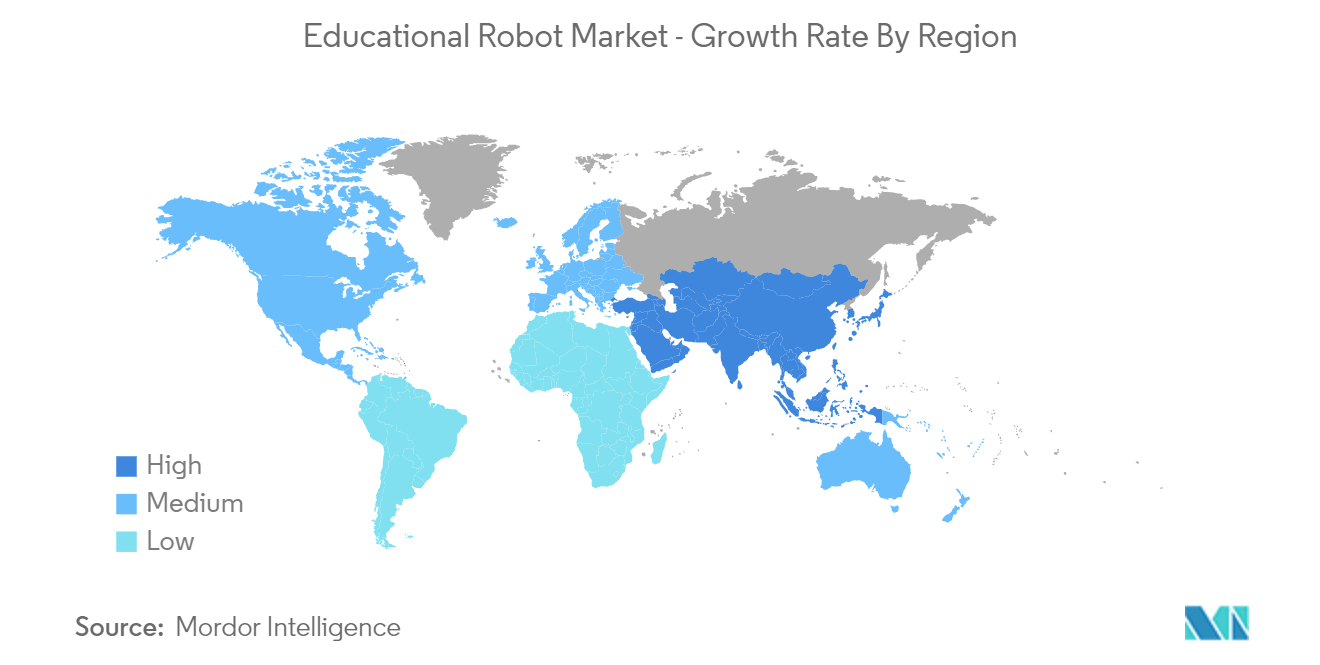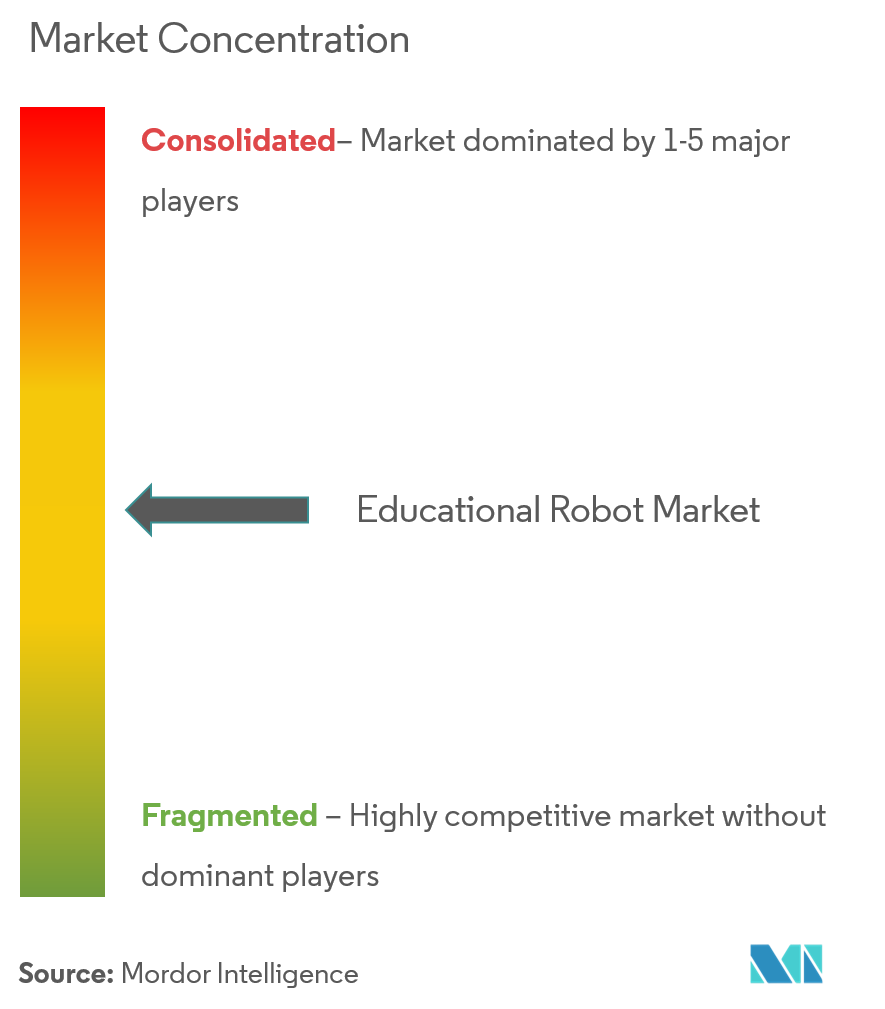Educational Robots Market Analysis
The Educational Robot Market is expected to register a CAGR of 16% during the forecast period.
- Robots can also help children that are homeschooled or teach in areas where human experts are short in supply. For instance, in South Korea, a robot, Robosem, is teaching English where certified English teachers are rare. Similarly, a robot named Keeko narrates stories, possesses logical questions, and interacts with a student using facial expressions in China.
- The use of robotics in learning is ideal for interaction in classrooms as it improves social interaction and encourages collaboration among young children. Playing (and learning) with robots also offer additional benefits for students with disabilities.
- Students with Autism can be very responsive to robots. Robots provide a solution for students with Autism to practice social skills without the pressure of interacting with a real person. Milo (Robokind) is one of the examples of technology being used in schools and clinics for children with an autism spectrum disorder. The robot helps people with Autism in learning social, emotional, and communication skills.
- Moreover, the growing number of individuals with Disabilities Education Act in the United States is also expected to drive the need for educational Robots. According to the Office of Special Education Programs, the number of children aged between 3 to 21 years suffering from Autism accounted for 828 thousand during 2020/2021, compared to 94 thousand in 2000/2001.
- Moreover, robots are increasingly being adopted as teaching assistants or advanced learning tools. One of the teachers at Wellington College (United Kingdom) has predicted that artificially intelligent robots will likely replace educational teachers in the next few years.
- However, high initial investments and maintenance are expected to be one of the major restraints as the robots require a timely update on educational content and require good battery life for conducting classes for hours without recharging.
- While the COVID-19 pandemic increased demand to entertain and educate children, and vendors have been focusing on product launches, Roybi Inc. relaunched its robot Roybi along with the DOCBI model amid current challenges. However, post the pandemic, the requirement for homeschooling and online training increased, which is expected to offset the market growth slightly.
Educational Robots Market Trends
Humanoid Robots Expected to Witness Significant Growth
- Studies have shown that teaching processes incorporating robotic-based engagement methods can approach the effectiveness of a human tutor. Not only have these socially-engaging robots used in education but also as weight-loss coaches, play partners, and a companion.
- Moreover, robots can be updated with various current knowledge and teaching methods. Apart from an initial investment, they do not require much more than electricity to run and are cost-effective. These features add up to their appeal as teachers and are expected to drive the demand during the forecast period.
- Since the use of humanoids as a teacher has received a positive response in the education segment, the market is poised to gain investments in the upcoming years. The humanoid 'Pepper' from Softbank Robotics has already witnessed widespread adoption among the education segment and is expected to witness much more adoption in the near future.
- For robots to teach successfully, they need to be able to communicate socially. Technological developments made by the vendors in the market are emphasizing this aspect, and it is considered the biggest challenge with robots as teachers right now.
- Moreover, humanoid teaching assistant robots are being designed to provide assistance during lectures and enable them to save time by checking students' prerequisite knowledge, summarising responses and providing feedback, setting learning tasks, and others. This saves time for the teacher and teaching assistants and enables them to focus on providing individual attention to learners with experience.
- The growing number of teaching assistants in the United States is mostly aged above 44 years old, according to Zippia, and the number of assistant teachers in 2021 accounted for 2,263,301, of which 78% were females and 22% were males. In order to remove gender bias, universities may also switch to humanoid robots for education.
Asia-Pacific Expected to Witness Significant Growth
- The Asia-Pacific region is highly likely to adopt educational robots in various educational institutions as there are some widespread government initiatives in the region that are primarily aiming to improve the literacy rate in the region.
- The region is considered one of the biggest innovators in the consumer robot space. Moreover, as the region's most innovative robotics start-ups continue to innovate and develop their products, they are utilizing every opportunity to expand globally.
- Some of the major vendors that offer educational robots for STEM courses is Comau. The company offers e.DO robot in China, which is specifically designed to help students of different age groups for learning both STEM and humanities subjects, as well as explore robotics technology in a more engaging and innovative way.
- Moreover, various government initiative by many countries in the region is expected to drive the market. For instance, the government of India plans to establish the Atal Tinkering Laboratories (ATL) in schools across the country with an aim to foster creativity, curiosity, and imagination in young children. It will also help children inculcate skills, such as computational thinking, design mindset, adaptive learning, physical computing, etc.
- Under this initiative, children will get a chance to work with various tools and equipment to understand the basic and advanced concepts of STEM (Science, Technology, Engineering, and Math). Students in the ATL's will be equipped with educational and learning kits and equipment on science consisting of robotics, electronics, open-source microcontroller boards, sensors with 3D printers, and computers.
Educational Robots Industry Overview
The educational robot market is highly competitive owing to the presence of several small and large players in the market supplying their products in the domestic and international markets. The market appears to be moderately concentrated, with the key players adopting strategies like product innovation, among others, primarily to increase their product functionality and expand their geographical presence. Some of the major players in the market are SoftBank Robotics, Hanson Robotics Limited, Wonder Workshop, and Blue Frog Robotics, among others.
- October 2022: EZ-Robot announced a strategic reseller partnership with School Specialty to expand the former further reach into the US market for educational robotics and equip students with robotics and AI skills to address the technological changes worldwide.
Educational Robots Market Leaders
-
SoftBank Robotics
-
Hanson Robotics Limited
-
Wonder Workshop
-
Blue Frog Robotics
-
Sanbot Innovation Technology, Ltd
- *Disclaimer: Major Players sorted in no particular order
Educational Robots Market News
- August 2022: Google is focusing on aiding the market's requirements for humanoid robots; researchers in google's lab have developed AI software that incorporates large language models to help humans achieve everyday tasks. Such research is also expected to drive changes in homeschooling in the near future.
- March 2022: ElliQ, Intuition Robotics' digital care companion was officially commercialized and is presently offered for purchase at elliq.com.
Educational Robots Industry Segmentation
Educational robots have the latest computing power and innovative engineering and can also be controlled via apps and by using voice and gestures. These robots can enhance creative problem-solving techniques and encourage the development of essential communication and interpersonal skills, as well as the ability to collaborate and convey complex ideas to fellow students.
The study analyzes the type of educational robot across geographies, which include North America, Europe, Asia-Pacific, and the Rest of the World. It tracks the key demand-side market dynamics based on base indicators, such as demand for different types of educational robots.
The educational robot market is Segmented by Type (Humanoid, Non-Humanoid) and Geography (North America, Europe, Asia-Pacific, and the Rest of the World).
The market sizes and forecasts are provided in terms of value (USD million) for all the above segments.
| Type | Humanoid |
| Non-humanoid | |
| Geography | North America |
| Europe | |
| Asia-Pacific | |
| Rest of the World |
Educational Robots Market Research FAQs
What is the current Educational Robot Market size?
The Educational Robot Market is projected to register a CAGR of 16% during the forecast period (2025-2030)
Who are the key players in Educational Robot Market?
SoftBank Robotics, Hanson Robotics Limited, Wonder Workshop, Blue Frog Robotics and Sanbot Innovation Technology, Ltd are the major companies operating in the Educational Robot Market.
Which is the fastest growing region in Educational Robot Market?
Asia-Pacific is estimated to grow at the highest CAGR over the forecast period (2025-2030).
Which region has the biggest share in Educational Robot Market?
In 2025, the North America accounts for the largest market share in Educational Robot Market.
What years does this Educational Robot Market cover?
The report covers the Educational Robot Market historical market size for years: 2019, 2020, 2021, 2022, 2023 and 2024. The report also forecasts the Educational Robot Market size for years: 2025, 2026, 2027, 2028, 2029 and 2030.
Our Best Selling Reports
Educational Robot Industry Report
Statistics for the 2025 Educational Robot market share, size and revenue growth rate, created by Mordor Intelligence™ Industry Reports. Educational Robot analysis includes a market forecast outlook for 2025 to 2030 and historical overview. Get a sample of this industry analysis as a free report PDF download.

